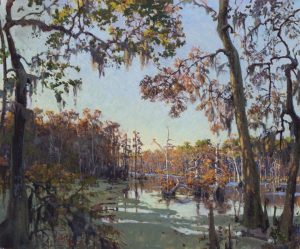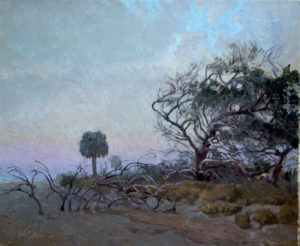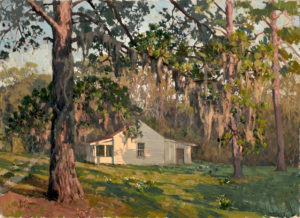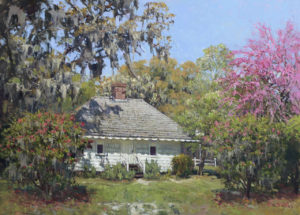Tag Archives: carolina gold
6
Feb
What do you know about Hobcaw Barony?
Opening on January 28th The Gibbes Museum in Charleston, S.C. is exhibiting a show of West Fraser’s work, many of the paintings are ones featured in ‘Painting the Southern Coast’. This exhibit is the 9th one-man show of Mr. Fraser’s work, and the 3rd one-man show at The Gibbes Museum.
Painting the Southern Coast: The Art of West Fraser, published by the University of South Carolina Press in July 2016, shares not only Mr. Fraser’s talent as an artist, but also his love of the area he calls ‘My Country.’ “Painting the Southern Coast’ contains history, art, as well as insight into the things Mr. Fraser finds compelling. The book is divided into seven sections, starting with Georgetown, S.C. and continuing along the ‘Georgia Bite’ to St. Augustine, Florida. Follow along with us as we give you a bit more insight into the areas that West explores with his art. Some of the information will be historical in nature, other information will be personal, and of course all will encompass West Fraser’s wonderful light filled paintings. As with the book, we will start in Georgetown County with Hobcaw Barony, one of the largest land grants in South Carolina and the area which would provide South Carolina with much of its income before the ‘War of Northern Aggression,’ through its vast fields of ‘Carolina Gold.’

‘Washo Reserve’ | Santee Coastal Reserve, S.C. | 30 x 36 inches Oil | 2014
Hobcaw and waccamaw are familiar names in the South Carolina lowcountry. To the native americans, these words defined the area which carries the name– ‘between the river,’ or ‘coming and going.’ Hobcaw Barony was the name given to the largest of the land grants in Georgetown, South Carolina and encompasses the area between Winyah Bay and the Atlantic Ocean. Winyah Bay is fed by several rivers originating in the upstate—the Black, Pee Dee, and Sampit—also named for Native American tribes who populated South Carolina.

‘Winter Fog’ | De Bordieu, S.C. | 20 x 24 inches Oil | 2008
The colonial land grant known as Hobcaw Barony was established in 1711 and was later subdivided into individual plantations by Lord John Carteret one of King George’s lord proprietors. The area was the second largest producer of ‘Carolina Gold’ rice and was also a well known producer of American caviar and indigo. Georgetown was an important stop on the King’s Highway, which was established by King Charles II as a means for the colonies to better communicate with one another and extended from Charles Towne all the way to Boston.

‘Slave Cabin on the King’s Highway’
Hobcaw Barony, Georgetown, S.C. | 24 x 36 inches Oil | 2008
In the early 1900’s successful Wall Street financier, Bernard Baruch, purchased Hobcaw Barony for use as a hunting preserve. The plantation was visited by many of the influential men of the day including Winston Churchill. When Bernard died, he left the property to his eldest child, Isabelle W. Baruch.

‘Many Springs’ | Hopsewee Plantation, Georgetown, S.C. | 26 x 36 inches Oil | 2014
Belle, as she was known, led a life of great accomplishment. She was a great sportsman–sailing, hunting, and riding were her greatest passions, along with a care for the environment in which she lived. ‘The preservation of this pristine living laboratory was made possible by the extraordinary foresight of Isabelle Wilcox Baruch, known to all as “Belle”—a remarkable woman well ahead of her time. She was a conservationist in an era when that word was barely understood, much less widely used. She was also an intense competitor who thrived on challenge, fought against long odds with grit and tenacity, and was determined to govern her own destiny in a world that, because she was a woman, often tried to tell her what to do.’ (Charleston Magazine ‘The Baroness of Hobcaw” September 2013. Also of interest in reference to Belle Baruch and art.)
We are fortunate to be able to visit Hobcaw Barony and immerse ourselves in the plantation culture of the past. Learning, and understanding, the past is a great way of helping to guide us in the future. For more information about Hobcaw Barony, or to donate to the foundation, please visit http://www.hobcawbarony.com
For information about ‘West Fraser’s book Painting the Southern Coast: The Art of West Fraser’ USC Press 2016, reproductions, or original art, please visit https://westfraserstudio.com or http://www.helenafoxfineart.com
Read More »
30
Sep
What Is A Chicken Bog Anyways?
We all know that rice was grown in the lowcountry during the colonial era. There are reminders everywhere of our by-gone rice culture. But have you ever thought about what happened to these fields after they stopped growing rice? Many of them were sold to wealthy northerners for hunting plantations. Evidently the rice fields became a wonderful home for ducks.
Read More »
Categories
- architecture (1)
- Art and Antiques Magazine (1)
- Art for Sale (1)
- Artist (1)
- artist travels (2)
- beauty (1)
- Books (1)
- buy art (3)
- carolina gold (2)
- Charleston (3)
- charleston artist (10)
- charleston gallery (8)
- Charleston In My Time (2)
- Charleston Magazine (4)
- charleston mercury (2)
- charleston sc (1)
- conservation (2)
- corner store (1)
- Explore Charleston (6)
- garden and gun (2)
- gibbes museum of art (4)
- Helena Fox Fine Art (8)
- italy (2)
- lowcountry (3)
- lowcountry artist (4)
- lowcountry history (2)
- new book (1)
- old buildings (1)
- Painting The Southern Coast (11)
- plein air (3)
- representational artist (4)
- so charleston (2)
- son of the lowcountry (10)
- South Carolina (2)
- southern artist (1)
- southern history (3)
- street scenes (2)
- tuscany (2)
- University of South Carolina Press (6)
- vanishing charleston (2)
- Wall Street Journal (3)
- West Fraser (8)
- west fraser artist (14)
- west fraser studio (13)
- wet fraser artist (2)